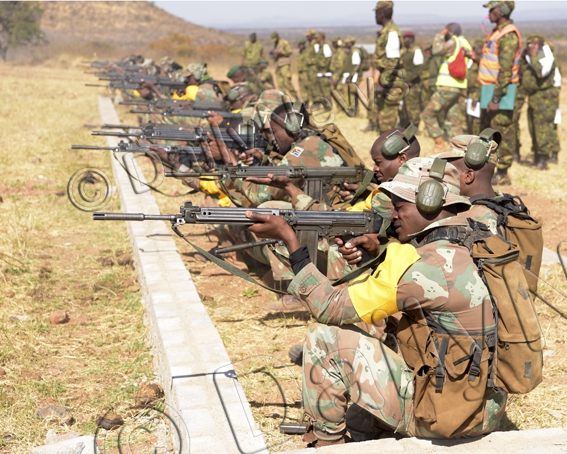Security sector integration a tool for peace in the SADC region
25 Nov 2019
The Southern part of Africa is one of the most stable regions in the African continent due to democratisation and security cooperation by member states with the exception of the Democratic Republic of Congo which is still involved in a low intensity conflict.
Southern African Development Community(SADC) member states have deepened their interactions on security and defence cooperation through joint training exercises to build trust and common values, and prepare for future joint deployments in conflict affected areas.
In an article titled, The challenges of regional integration in Southern Africa, published in the African Journal of Political Science, researchers Mark Chingono and Steve Nakana posit that SADC has endeavored to foster economic cooperation, the assumption being that neighboring countries that have similar economic, socio-political and security problems may benefit from integrating their economies because this creates a situation of mutual interdependence and development.
The need for peace and security, and economic and social development through regional integration are key drivers of regional organisations. In addition, closer regional security cooperation by member states is vital for the maintenance of peace in the region.
Security cooperation in the region has of late manifested itself in the form of joint security exercises by militaries and cross-border police cooperation to fight crime, the objective of which is to create stability and understanding between nations, build personal and institutional links between the countries’ military forces, and reinforce political, economic and cultural linkages.
The joint security exercises have also been touted as necessary for coalition building and promoting tactical inter-operability within SADC forces, and as instruments for maintaining institutional, geographic and capability familiarity, including the validation of tactics, techniques and procedures for use in peacekeeping missions.
SADC has moved swiftly to prioritise security sector integration with a view to protecting the region’s people from instability due to the breakdown of law and order and cooperating on matters related to security and defence. However, this process has not been smooth due to lack of common values among member states.
In an effort to deepen security integration, in 1996, SADC created the Organ on Politics, Defence and Security, a framework for coordinating policies and activities on politics, defence and security. Further to this, SADC passed the Protocol on Politics, Defense and Security Cooperation in August 2001.
In compliance with the provisions of this protocol, SADC went further and developed the Mutual Defense Pact in 2003 to operationalise the mechanisms of the organ and for mutual cooperation in defence and security matters.
The pact focuses on issues of conflict resolution, military preparedness, collective self-defense and self-action, destabilizing factors and settlement of disputes.
However, writing in the African Research Review in an article titled, Regional Integration and Conflict Management in Africa, researcher, Sunday Ebaye noted that operationalising the organ for politics, defence and security had been challenging.
Botswana, as a founding member of SADC has played a key role in efforts to integrate the security sector by ensuring that the Botswana Defence Force and Botswana Police Services participate in joint regional exercises.
As a way of deepening defense cooperation in 2005, SADC moved a step closer to forming a rapid response brigade for deployment in peacekeeping operations and hotspots on the continent and elsewhere.
In an effort to operationalize defense integration in the SADC region, a SADC Standby Force and SADC Brigade which supports regional peace operations under the African Standby Force Policy Framework was launched in 2008.
The brigade is made up of military, police, and civilian members from SADC member states. Its function is to participate in missions which include observation and monitoring, peace support missions, interventions for peace and security restoration at the request of member states.
The SADC Brigade as a tool of the SADC Organ on Politics, Defence and Security Cooperation, serves in peace-building and humanitarian assistance in conflict areas and areas impacted by major natural disasters.
Training for this brigade takes place at the Regional Peacekeeping Training Centre located in Zimbabwe and other national peace support training institutions.
The centre has also participated in the preparation and running of all major peacekeeping exercises conducted in the region.
In April 1997, SADC kick-started its defence cooperation with a simulation exercise code-named Exercise Blue Hungwe in Nyanga, Zimbabwe which was aimed at preparing SADC military for peacekeeping missions.
About 1 570 troops from South Africa, Tanzania, Botswana, Mozambique, Swaziland, Namibia, Lesotho, Malawi and Zimbabwe took part. The aim of the exercise was to enhance sub-regional liaison, cooperation, military skills and inter-operability by means of a multinational joint field training exercise in the tactics and techniques of international peacekeeping.
This form of defense cooperation allows neighboring countries to operate together, build friendship and good neighborliness. Cooperation and integration in the security sector was also necessitated by the fact that foreign powers are not always willing to become involved in Africa’s internal conflicts.
Researcher, Theo Neethling, writing in an article titled, ‘Military Intervention in Lesotho: Perspectives on Operation Boleas and Beyond’, published in the Online Journal of Peace and Conflict Resolution explained that in September 1998 after post-election violence in Lesotho, SADC launched a military intervention led by the South African National Defence Force and the Botswana Defence Force to restore law and order in the politically fractious mountain kingdom in an operation code-named, Operation Boleas.
Mark Malan, in his article ‘Peacekeeping in Africa-Trends and Responses’ published at the Institute of Security Studies noted that Operation Blue Crane, held in South Africa at the Lohatla Battle School in the Northern Cape in 1999 saw four thousand SADC troops from 12 countries participating in the peacekeeping exercise. South Africa has also hosted Exercise Golfinho in 2009, whose objective was to test the readiness and capability of the SADC Brigade to handle conflict situations in line with the evolving international peacekeeping framework.
According to the Institute of Security Studies, in November 2015, the SADC Standby Force attained its Full Operational Capability after the successful conduct of Amani Africa II Field Training Exercise held in Lohatla, South Africa, within the framework of the African Standby Force, as an integral component of the African Peace and Security Architecture.
Troops from SADC member states also took part in Exercise Tanzanite, a peacekeeping exercise in the Tanga region of Tanzania in February 2002, where the simulation exercise included deploying in a fictitious civil war destabilized country.
The exercise, which also involved the International Committee of the Red Cross, endeavored to familiarise armed forces with the humanitarian activities of the Red Cross in conflict areas.
Tanzanite assisted in equipping troops with a better understanding of respective mandates of a humanitarian organization and a military mission. ENDS
Source : BOPA
Author : Puso Kedidimetse
Location : FRANCISTOWN
Event : interview
Date : 25 Nov 2019









